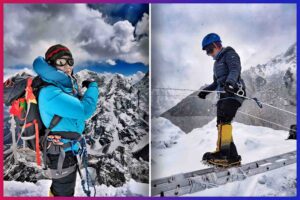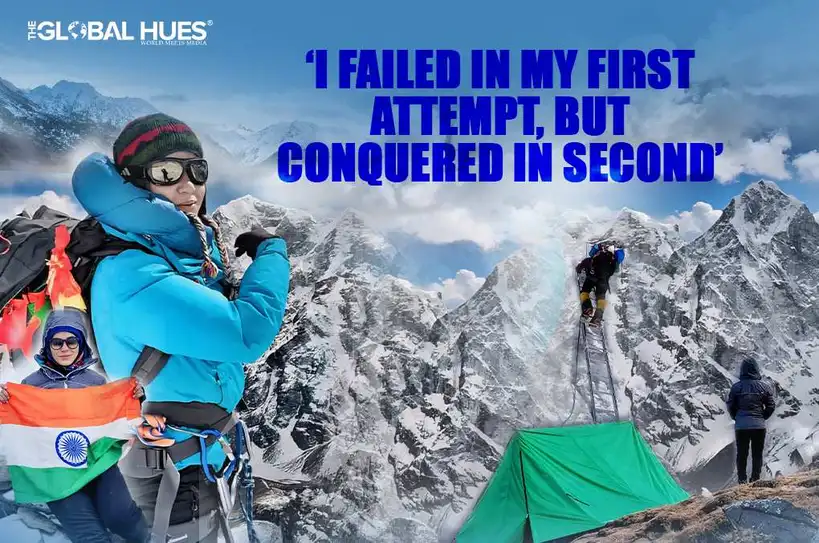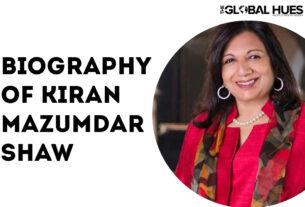Reaching the top of Mount Everest always seems like an ultimate dream or a thing that has to be ticked off a daredevil’s list. The cold air that hits you, the difficulty in breathing properly, the changing weather, and the frozen or half-buried bodies you might see would dissuade anyone from climbing. However, after Bachendri Pal, the first Indian Female Mountaineer who reached the summit of Mount Everest in 1984, the dream now seems achievable. Since then, many women have climbed Mount Everest, rising above challenges and breaking barriers with each step. One of them is Ameesha Chauhan.
She is the first Indian hearing impaired to summit Everest. She recently became the first woman participant to represent India at the Winter Deaflympics 2024 in Erzurum. Ameesha has also represented the nation in Alpine Skiing events.
Let’s hear why she chose to scale Mount Everest, the challenges she faced and how she felt reaching the summit.
1. What motivated you to climb Mt Everest, and how did you prepare for such a challenging expedition?

As a child, I wanted to become a pilot and soar through the skies in an aeroplane or a helicopter, yet the dream still needed to be fulfilled. I believed that scaling the summit of Mount Everest would help me achieve my dream of soaring in the skies. As I didn’t have proper knowledge about the mountain peaks, I completed a comprehensive basic mountaineering course, advanced mountaineering training, search and rescue training and a method of instruction course.
After completing these courses, I started going on expeditions to the lesser peaks ranging from 5000m to 6000m before I made preparations for scaling Mount Everest. Before my Everest Summit, I had successfully conquered seven different summits. I successfully climbed Mount Everest in 2019.
2. According to you, how important it is to limit permits to experienced climbers? How do you believe this could prevent future tragedies on Mt Everest?
I have been a survivor of the Mount Everest “traffic jam.” The Hillary step is the most dangerous step and climbers used one rope to descend and ascend. When I was stuck in the queue; I couldn’t move for a few minutes. I saw dead bodies around me on the Hillary Step and I had to cross over them to descend. That’s why I believe the state government should limit the permit only to well-trained climbers with mountaineering experience.
The only downside of limiting permits solely to experienced climbers may stagnate the sport’s growth and deter potential newcomers from getting into mountaineering. It is important to encourage diversity in climbing groups by creating a mix of experienced and first-time climbers as it helps foster a supportive and inclusive climbing community.
3. Can you share any advice or lessons learned from your experience on Mt Everest for aspiring climbers or adventurers?
I have made two attempts to climb Everest. My first attempt was on May 16, 2019, when I found myself just short of 100 meters of the summit peak. Unfortunately, my Sherpa’s oxygen cylinder got depleted and he was willing to continue further. I was heartbroken, yet I made a difficult decision and retreated to the base camp. Despite all the heartbreak and despair, I didn’t give up on my dream. After I returned to the base camp, I decided to make a second attempt during the next climb window.
My second climbing attempt happened on May 23, 2019. I reached the summit of Mount Everest and proudly unfurled my flag. As I was standing on top of the summit, I felt an overwhelming sense of accomplishment as I had silenced all those who doubted my ability to conquer Everest once more. From the summit, I proclaimed to the world that women are not frail and one should never let courage falter. I believe that if one believes in oneself, there are no limits to what one can achieve.
4. How do you plan to raise awareness about the dangers of overcrowding and insufficient training among climbers?
As I have mentioned above, limited permits should be given to experienced mountaineers. However, there is a downside to that as well. I believe awareness can be created by encouraging diversity in climbing groups, i.e., pairing experienced with first-time climbers. When people in the climbing groups embrace several skills, it helps create opportunities for mentorship and skill development among participants. Furthermore, the climbing community thrives when they become inclusive and when climbers engage with other climbers through social media platforms and personal interactions, it helps facilitate networking opportunities and enhance the sense of community within the sport.
5. Looking back on your journey, what was the most significant takeaway or lesson you learned from your experience on Mt Everest?
I felt like I had failed when I returned to the base camp falling short of the summit by a mere 100 metres in my first attempt. Yet, I refused to give in to sadness and despair and within a week, I climbed Mount Everest again. I finally succeeded. It still baffles me that in one week, I experienced both failure and success. From this experience, I have learned never to give up and to view failure as a stepping stone towards success.




